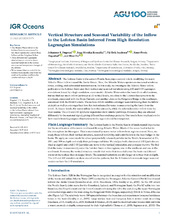Vertical structure and seasonal variability of the inflow to the Lofoten Basin inferred from high resolution Lagrangian simulations
Dugstad, Johannes Sandanger; Kozalka, Inga Monika; Isachsen, Pål Erik; Dagestad, Knut-Frode; Fer, Ilker
Peer reviewed, Journal article
Published version

Åpne
Permanent lenke
https://hdl.handle.net/1956/21563Utgivelsesdato
2019-11-13Metadata
Vis full innførselSamlinger
- Geophysical Institute [1198]
Originalversjon
https://doi.org/10.1029/2019jc015474Sammendrag
The Lofoten Basin in the eastern Nordic Seas plays a central role in modifying the warm Atlantic Water inflow toward the Arctic Ocean. Here, the Atlantic Water experiences increased residence times, cooling, and substantial transformation. In this study, we investigate the Atlantic Water inflow pathways to the Lofoten Basin and their vertical and seasonal variations using 2‐D and 3‐D Lagrangian simulations forced by a high‐resolution ocean model. Atlantic Water enters the basin from all directions, but we find two main inflow pathways at all vertical levels, one close to the Lofoten Escarpment in the southeast, associated with the Slope Current, and another close to the Helgeland Ridge in the southwest, associated with the Front Current. The surface inflow exhibits a stronger seasonal forcing than the inflow at depth as well as a stronger heat loss that is dominated by water masses entering the basin from the south. At deeper levels, the warm inflow from the east cools, while the relatively colder inflow from the west warms. The 2‐D and 3‐D synthetic trajectories show similar pathways. However, they are affected differently by the seasonal signal, giving different heat exchange patterns. Our results have implications for how results from Lagrangian observations in the region should be interpreted.
